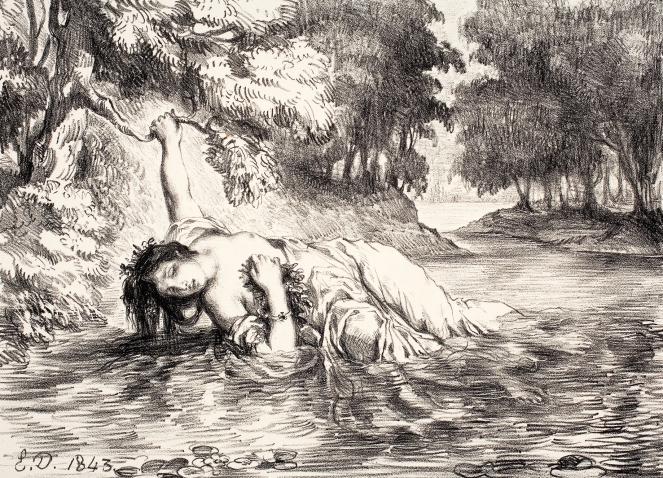Did she fall, was she pushed, or did she jump? These are the questions that arise from this dramatic lithograph, Mort d’Ophélie (Death of Ophelia), by French painter and printmaker Eugène Delacroix (1798–1863). The print was on display at the recent Davis Museum exhibition, That Right Promethean Fire: Shakespeare Illustrated, which marked the 400th anniversary of the playwright’s death.
Ophelia’s character in Hamlet has long been debated. To some, she is merely a plot device: Her madness and death serve as the justification for her brother, Laertes, to challenge Hamlet in the final scene. To others, she’s a symbol of women’s low status in a patriarchal order. Delacroix renders her as a flesh and blood woman. He depicts her face with exquisite delicacy, showing her despair as she clings to the willow branch: “When down her weedy trophies and herself / Fell in the weeping brook.”
Her clothing, already in disarray, is dragging her under the dark, rippling water. She clutches her “fantastic garlands” to her breast with one hand; with the other she grasps the branch. It’s difficult to tell if she is lowering herself into the water or trying to pull herself out. Shakespeare’s recounting of her death, which occurs offstage, has fueled theories that Ophelia was murdered. Her supposed mad ramblings do seem to have a hidden meaning.
Delacroix had seen Hamlet performed in 1827 in an English production in Paris, and the play haunted him. Mort d’Ophélie is one of 13 lithographs he created for an 1843 series depicting key scenes from the play. He later added three prints of scenes he had initially left out. Although the series did not at first excite critics, it has come to be considered among Delacroix’s finest work.
The Davis Museum owns three of the Hamlet lithographs, which were displayed in the exhibition along with other Shakespeare-related works such as books (including a prized copy of the Second Folio of 1632), paintings, prints, and photographs from the Davis Museum, Special Collections of the Clapp Library, Wellesley College Archives, and Shakespeare House. The archives provided a set of charming 1890s photographs of Wellesley students performing As You Like It and A Midsummer Night’s Dream.
The exhibition also traced the vitality of Shakespeare scholarship from the College’s earliest days, demonstrating the immense importance placed on the teaching and appreciation of one of the greatest writers in the English language.






We ask that those who engage in Wellesley magazine's online community act with honesty, integrity, and respect. (Remember the honor code, alums?) We reserve the right to remove comments by impersonators or comments that are not civil and relevant to the subject at hand. By posting here, you are permitting Wellesley magazine to edit and republish your comment in all media. Please remember that all posts are public.